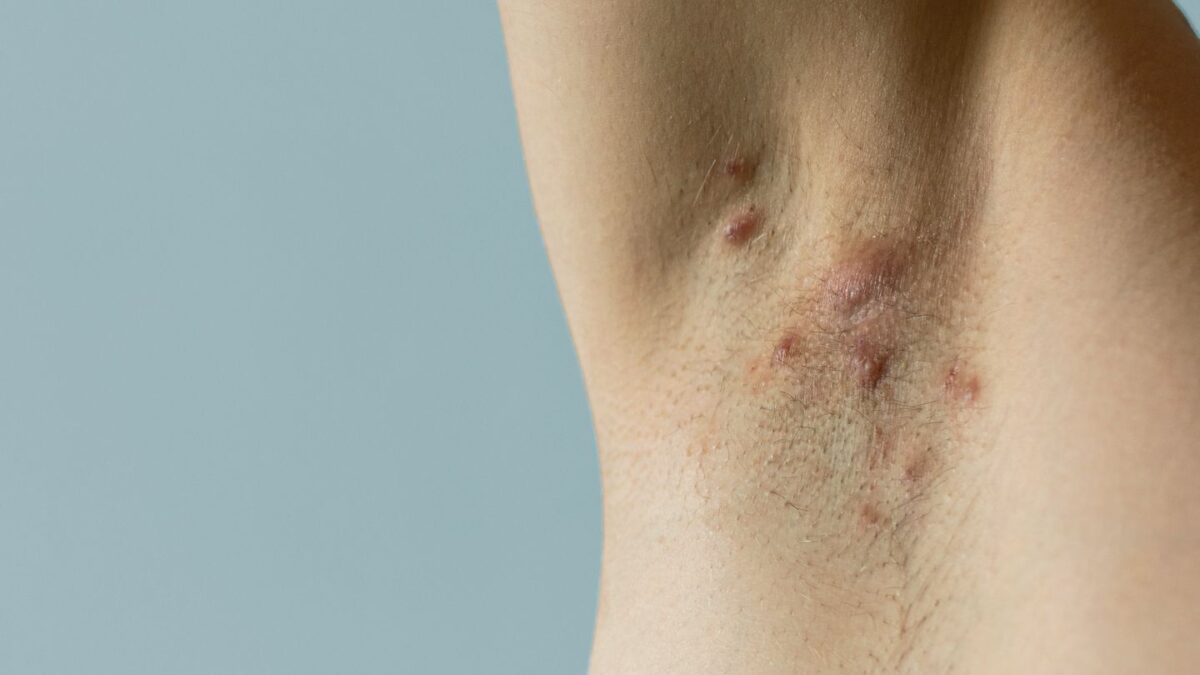Because there isn’t just one factor that fuels the development of the skin condition, there are several potential hidradenitis suppurativa (H.S.) causes to be aware of. Many researchers are still puzzled as to why H.S. occurs in some people. Understanding the underlying causes can help experts better understand hidradenitis suppurativa treatment options.
Hidradenitis suppurativa is a chronic skin condition characterized by painful lumps under the skin. Symptoms usually appear where your skin rubs together, and the bumps or sores can leak pus or odorous fluid. Tunnels may form beneath the skin in severe cases, connecting the lesions.
Hydradenitis suppurativa affects between 1% and 4% of people in the United States, and it can be physically and emotionally painful for many of them. People with hidradenitis suppurativa frequently report feeling self-conscious about the appearance of their skin due to the stigma associated with the condition. That is why it is critical to understand the risk factors for hidradenitis suppurativa and to understand that you are not to blame for having the condition. Here are some of the things that can cause hidradenitis suppurativa.
1. Hormonal Fluctuations
There is some evidence that women with hidradenitis suppurativa experience flare-ups around their menstrual cycle. In a small study of 279 people, nearly 77% reported that their hidradenitis suppurativa symptoms worsened during their period. Because higher estrogen and progesterone levels are thought to help keep inflammation low, lower estrogen and progesterone levels may cause flares.
2. Age
People typically develop hidradenitis suppurativa lesions between puberty and their forties. Puberty causes an increase in sex hormones, which may explain why H.S. cysts appear after this time. However, many people with hidradenitis suppurativa can go years without receiving an accurate diagnosis because their H.S. cysts are misdiagnosed as boils or infections.
According to research, it can take seven to twelve years for some people to be diagnosed with hidradenitis suppurativa after they first exhibit symptoms, so not everyone who develops H.S. during puberty will be diagnosed at that time.
3. Smoking
Many people with hidradenitis suppurativa have a history of cigarette smoking, according to numerous studies. According to the AAD, roughly 70% to 90% of people with hidradenitis suppurativa have smoked. Although research into why this occurs is ongoing, experts believe nicotine and other chemicals in tobacco smoke may promote pro-inflammatory cytokines, which are molecules that cause inflammation.
4. Weight
According to research, there is a link between hidradenitis suppurativa and being medically classified as overweight or obese. According to research, this may occur because larger-bodied people have more skin folds, which may cause friction and follicular occlusion.
There are numerous reasons why discussing weight as a risk factor is difficult, including the fact that the number on the scale can be influenced by factors beyond a person’s control, such as access to fresh food.
In fact, losing extra pounds can not only improve the condition but also overall health. If you have trouble losing weight, consider visiting a weight loss clinic. Specialists will help you achieve your desired weight in a safe way.
5. Other Chronic Conditions
Certain chronic conditions are more common in people with hidradenitis suppurativa, and vice versa. Inflammatory bowel disease, metabolic syndrome, severe acne, arthritis, and diabetes are examples of these conditions.
However, all of these conditions are associated with increased levels of bodily inflammation, which could explain the link to hidradenitis suppurativa.
6. Race
According to new research, Black and Hispanic people are disproportionately affected by hidradenitis suppurativa. This could be because Black people have a higher rate of metabolic syndrome, which is one of the risk factors for hidradenitis suppurativa.
Furthermore, studies show that Black skin is underrepresented in textbooks, which means that doctors may struggle to accurately diagnose complex skin conditions like hidradenitis suppurativa in people with darker skin tones. Furthermore, medical conditions primarily affecting women at birth do not receive the same level of funding as diseases primarily affecting men at birth.


